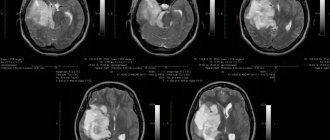| Calling a psychiatrist to your home from RUB 3,500. | 24-hour hospital from 6000 rub. | Outpatient treatment from 4500 rub. | Hospitalization (transportation) to a hospital from 2000 rubles. | Psychiatric examination from 1500 rub. |
Fears or phobias are caused by strong feelings and excessive anxiety in specific situations or in anticipation of the manifestation of an unusual object.
What are fears and phobias - in the field of psychiatry, a phobia is usually called a pathology in which a strong fear of various factors or objects develops. Phobias are expressed by seriously impassable fear, which is irreversibly aggravated in certain situations and cannot be fully explained logically. As a result of the development of a phobia, a person begins to fear and therefore avoid certain objects, activities or situations.
Treatment of fears and phobias in a hospital. Prices
| Economy | Standard | VIP chamber |
| 6000 rub./day | 7000 rub./day | 8000 rub./day |
The hospital price already includes:
- Full diagnostics in the laboratory
- Individual therapy plan
- Medicines required for treatment
- Choosing a room to stay
- Balanced 3 meals a day from the chef
- Group and individual psychological therapy
- Regular monitoring of patient progress
- Therapeutic massage, exercise therapy
- Physiotherapy and yoga therapy
- Complete and constant cleaning of rooms
- Buffet open 24 hours a day
- Gym, table tennis room
- Free WI-FI, games, movie shows
- Convenient parking and walking area
Stages of treatment for phobia in hospital
To treat a phobic disorder in Moscow, you need to go through the most important stages:
- work through phobias;
- take antidepressants;
- use tranquilizers;
- undergo psychotherapy sessions.
1) Primary diagnosis
Before treating asthenic syndrome in Moscow, the patient undergoes a high-quality diagnosis, tests are collected and a full examination is carried out. Specialists also conduct psychological diagnostics, take tests, conduct an ultrasound examination, study a cardiogram, and the patient is examined by a neurologist.
2) Treatment plan.
Based on the collected data, tests and conversations with doctors, an individual treatment plan will be prescribed for the person. If the situation is controversial and the case is severe, professors and specialists will be involved in the problem to prescribe an individual plan for further treatment. They will select treatment options with medications and psychological therapy.
If a patient has an acute condition, he poses a danger to himself and his loved ones - a special team will come home to pick him up. They will help transport him to the hospital and treat this condition in the hospital.
3) Therapy. After establishing an individual therapy plan for indolent manifestations of the disease, the patient is treated with medications + psychological therapy (both alone with a specialist and in a group).
Benefits of treating phobias in a hospital
- 24/7 monitoring. Our doctors monitor the health of patients around the clock.
- Isolation from familiar surroundings. The patient cannot leave the center during the course of therapy. Only close relatives can visit him by appointment.
- Proper nutrition. For patients, we offer a varied menu and meals 3 times a day. All dishes are prepared by good chefs.
- Living with relatives. In our clinic you can live with relatives in the same room.
Hypnosis for panic attacks
A panic attack is a sudden onset of intense fear and anxiety, which is accompanied by vegetative symptoms: palpitations, sweating, difficulty breathing, dizziness, etc.
At the same time, a large release of catecholamines, substances produced by the adrenal glands, is detected in the blood of a person who has undergone a panic attack. The main substance is adrenaline, the “fear hormone”. It is present in the blood in a certain amount. Exceeding the norm leads to the development of a state similar to the state of fear.
PAs are not safe. Their consequences: disruption of the functioning of internal organs, increased blood pressure to high levels, development of nervous tics and obsessive movements. Such people develop fear of the social environment. In complicated, advanced cases there is a danger of suicide.
When there is a real threat, the resulting fear is a physiological reaction. But with panic attacks, an attack of fear occurs for no reason, or this reason is far-fetched.
Such conditions occur from several times a year to several times a day. Between attacks, a person has painful periods of waiting for them.
Experts distinguish three types of panic attacks:
- Spontaneous - they appear suddenly, for no apparent reason
- Situational – appear when the situation that led to the first panic attack is repeated
- Conditional-situational – appear under the influence of alcohol, drugs, medicinal substances
During panic attacks, different types of fear arise:
- Deaths from heart attack, stroke, suffocation. This is associated with the development of autonomic symptoms: rapid pulse, severe chest pain, pulsation of blood in the head, fainting
- Get sick with a serious illness
- Go crazy
A panic attack can be triggered by various severe emotional stresses, heavy physical activity, stimulants, alcohol, and improper use of medications.
But the most common reasons that can cause the development of PA are:
- Psychological trauma as a constant source of negative emotions
- Insurmountable circumstances in social and personal life
- Inability to release emotions, constant strict self-control over one’s emotional state
Similar factors and many others associated with the individual characteristics of the human psyche can lead to the development of pathological fear.
Features of treating panic attacks with hypnosis
An important condition for getting rid of panic attacks of fear and anxiety is their complete (not partial), radical, (not for a short time), their elimination. Drug treatment does not satisfy these conditions. And only hypnotherapy helps the autonomic system put itself in order, stabilize the level of adrenaline in the blood and nullify attacks of fear and anxiety.
A person in a trance state (the borderline state between wakefulness and sleep) is susceptible to external suggestion. A hypnologist works not with the analytical part of the brain, but with the subconscious, where other people’s attitudes become their own and then, being in a normal physiological state, a person is guided by them as his own.
Hypnotherapy scheme:
- Determining the cause of PA development
- Conducting sessions on suggestion and healthy attitude
- Rehabilitation
Stages of therapeutic hypnosis
It is important that the patient has a positive attitude towards it before hypnotherapy. He must completely trust the specialist. And the hypnologist, in turn, should not put pressure on the patient, he should competently lead him to the right decision.
Stages of hypnotherapy:
- Complete relaxation of the patient. It is achieved by special exercises and a comfortable position of the body.
- Putting the patient into a trance state. The hypnologist uses various techniques that disconnect him from the external world. He is ready to accept instructions from a hypnologist.
- Using speech commands to work with the patient's subconscious.
Types of hypnosis for PA
The following types of hypnosis are used to get rid of panic attacks:
- Classic, traditional. During the session, the specialist gives direct, strict instructions. It is necessary to find out whether it is suitable for the patient, since there are people who do not lend themselves to this type of hypnosis.
- Ericksonian, which uses soft settings and is more easily perceived by the patient. He has the opportunity to communicate with the hypnologist, which makes this type of therapy more trusting.
After the first sessions, patients immediately notice an improvement in their emotional and physiological state. Anxiety, nightmares, and depressing thoughts disappear.
The benefits of therapeutic hypnosis for panic anxiety and fears are:
- Quick results. It is unlikely that it will be possible to solve a complex problem in one session. But within 5-10 sessions, even long-standing problems disappear.
- Highly effective compared to drug treatment.
- Durability of results. Due to the fact that hypnotherapy focuses on the root of evil - the true cause of panic attacks, it has a lasting result, almost forever.
- Has no contraindications.
In addition, hypnotherapy teaches you to strengthen your “ego” and develop self-confidence. With the help of relaxation techniques, they can control their emotions and help them cope with stressful situations.
Today, hypnosis is an effective and cost-effective treatment for panic attacks. It is not addictive and safe for the human body.
Family therapy in the treatment of phobias
Treatment of fears with hypnosis, medications and the help of a psychiatrist in the treatment of phobias are necessary help for patients. But it is also important to pay attention to family psychotherapy with this illness. The help of a psychiatrist in treating fears for all family members is very important. Because it is the relatives who live with a sick person who can help him cope with phobias and fears. The doctor will also be able to quickly understand the causes and treatment of the patient’s phobias.
Who treats phobias - if you want to make an appointment with a psychiatrist in Moscow, pay attention to the qualifications of the specialists who will deal with the patients’ problems. In our clinic, neurologists, therapists and psychiatrists work with people with phobias and provide anonymous treatment.
Types of alarm
Depending on the various symptoms, anxiety can be classified to understand the problem and provide proper help. It happens:
- personal (tendency to worry for no apparent reason);
- situational (as a reaction to an event or situation).
The second option is the norm; a defensive reaction allows a person to prepare for upcoming problems and makes him cautious. In the first case, a person sees a threat in almost everything; any events, words and actions are regarded as a threat. In this case, specialist consultation and anxiety treatment are required.
If we divide anxiety according to the area of its occurrence, it can be:
- educational;
- interpersonal;
- social;
- elective.
Anxiety can affect a person in different ways, sometimes it mobilizes and stimulates actions aimed at reducing danger. At this time, the person becomes active, her stamina increases and her thought processes accelerate. With relaxing anxiety, volitional qualities are paralyzed and decision-making becomes difficult.
What happens if phobias are not treated?
If a person’s phobias are not identified in time, he or she will be at risk of developing the following consequences:
- serious depression;
- alcoholism and drug addiction;
- personality disorders;
- panic attacks.
- suicide attempts.
Below against the background of a mourning black ribbon. It is advisable to collect statistics on deaths according to WHO or other authoritative sources
The worst risk with phobias is that a person can commit suicide in this state.
Symptoms of phobias and their diagnosis
Symptoms directly depend on the type of disease. If a person is afraid of snakes, then when he gets into the same space with the “aggressor factor,” panic may begin. The same goes for other types of phobias. There are also common symptoms that unite all types of pathology. These include:
- Difficulty swallowing and a feeling of a “lump” in the throat.
- Dry mouth.
- Frequent urge to urinate.
- Diarrhea.
- Cardiopalmus.
- Breathing problems, shortness of breath
- Pain in the chest area.
- Dizziness, nausea.
- Noise in ears.
- Deterioration of vision.
- Trembling in limbs.
- Impaired concentration.
- Memory impairment.
- Increased sensitivity to noise.
- Excessive worry.
- Cramps.
- Pre-fainting state.
- A sharp increase in blood pressure.
Often the disease is accompanied by depression, depression and an obsession that something will happen soon.









